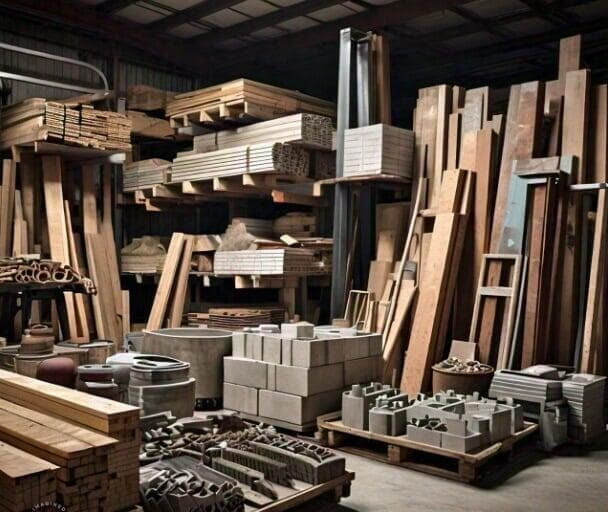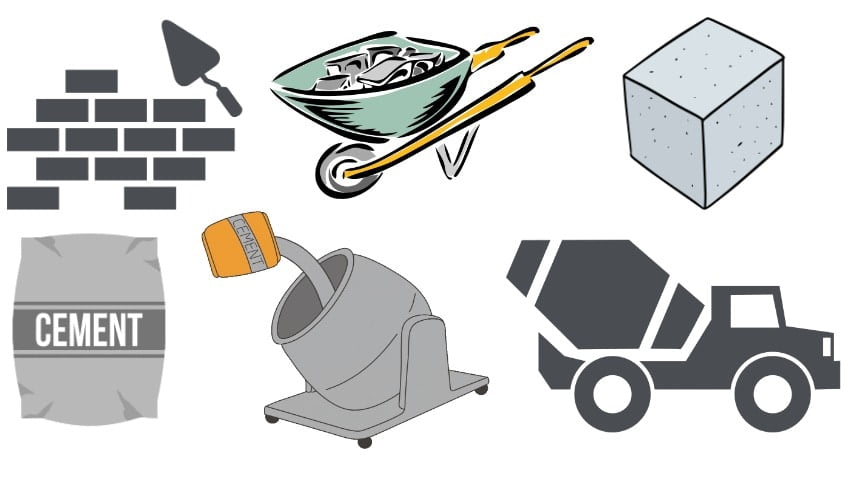Innovative Materials Leading the Way
Introduction:
The construction industry in India stands at a crucial juncture, poised for transformative change driven by innovation. As the country experiences rapid urbanization and infrastructure development, the demand for sustainable, efficient, and cost-effective construction materials has never been higher. In this context, the exploration of innovative and trending materials emerges as a pivotal strategy to address the evolving needs of the sector while fostering environmental sustainability and economic growth.
Traditionally, the construction sector has relied heavily on conventional materials such as concrete, steel, and bricks. While these materials have served their purpose, they come with inherent limitations in terms of environmental impact, resource depletion, and performance under diverse conditions. However, the advent of innovative materials offers a promising alternative, presenting opportunities to overcome these challenges and redefine the way we build our cities and infrastructure.
This exploration aims to delve into the realm of innovative materials in construction, focusing on their application and potential impact in the Indian context. From sustainable alternatives to high-performance composites and smart materials, the spectrum of innovation is vast and diverse. By embracing these advancements, India has the potential to not only enhance the quality and longevity of its infrastructure but also reduce its carbon footprint and contribute to global sustainability goals.
Moreover, the adoption of innovative materials aligns with the broader agenda of the Indian government to promote sustainable development and smart urbanization. Initiatives such as the Smart Cities Mission and Swachh Bharat Abhiyan underscore the need for innovative solutions that balance economic growth with environmental stewardship. Through strategic partnerships between government agencies, industry stakeholders, and research institutions, the integration of innovative materials can be accelerated, paving the way for a more resilient and sustainable built environment.
In this exploration, we will examine the spectrum of innovative materials available for construction projects in India, ranging from sustainable alternatives to cutting-edge technologies. Through case studies, market analysis, and future projections, we will unravel the potential of these materials to revolutionize the construction industry, driving progress towards a greener, more efficient, and resilient built environment.
Join us on this journey as we uncover the transformative power of innovative materials in shaping the future of construction in India and beyond.
- Introduction
- Traditional vs. Innovative Materials
- Potential Benefits of Using Innovative Materials in Construction Projects
- Sustainable Materials
- High-Performance Materials
- Recycled and Waste-Based Materials

Traditional vs. Innovative Materials:
Traditional Materials:
1. Concrete:
- Widely used for its versatility and strength.
- Relatively inexpensive and readily available.
- However, production of concrete contributes to significant carbon emissions.
- Prone to cracking and deterioration over time, leading to maintenance issues.
2. Steel:
- Known for its high tensile strength and flexibility.
- Commonly used in structural frameworks and reinforcements.
- Susceptible to corrosion, especially in humid or coastal areas.
- Production process involves high energy consumption and emissions.
3. Bricks:
- Historically popular for their durability and fire resistance.
- Natural thermal insulation properties.
- Resource-intensive manufacturing process, involving clay extraction and firing.
- Limited design flexibility and relatively slow construction pace.
Innovative Materials:
1. Sustainable Alternatives:
- Examples include bamboo, hempcrete, and rammed earth.
- Renewable and low-impact materials, reducing carbon footprint.
- Offer thermal insulation properties and aesthetic appeal.
- Limited availability and higher initial costs may pose challenges for widespread adoption.
2. High-Performance Composites:
- Utilize advanced materials such as fiber-reinforced polymers (FRP) and carbon fiber.
- Exceptional strength-to-weight ratio, enhancing structural performance.
- Resistant to corrosion, fatigue, and environmental degradation.
- Higher material costs may offset initial savings through reduced maintenance and longer lifespan.
3. Smart Materials:
- Incorporate technologies like self-healing concrete, shape-memory alloys, and smart coatings.
- Enhance functionality and adaptability of structures.
- Monitor and respond to environmental conditions, improving efficiency and safety.
- Research and development costs may be prohibitive for widespread adoption in mainstream construction.
Advantages and Disadvantages:
Traditional Materials:
- Advantages:
- Established supply chains and construction practices.
- Familiarity and widespread acceptance within the industry.
- Cost-effective solutions for many applications.
- Disadvantages:
- Limited sustainability and environmental impact.
- Vulnerable to degradation and maintenance issues.
- Relatively low resistance to extreme conditions and disasters.
Innovative Materials:
- Advantages:
- Potential for significantly reduced environmental footprint.
- Enhanced performance characteristics, including durability and resilience.
- Opportunities for innovation and differentiation in design and construction.
- Disadvantages:
- Higher initial costs and limited availability in some regions.
- Need for specialized skills and technologies for implementation.
- Uncertainty regarding long-term performance and compatibility with existing construction practices.
Potential Benefits of Using Innovative Materials in Construction Projects:
1. Sustainability: Innovative materials offer the potential to significantly reduce the carbon footprint and environmental impact of construction activities, aligning with global sustainability goals.
2. Performance: Advanced materials provide enhanced structural performance, durability, and resilience, resulting in longer lifespan and reduced maintenance requirements.
3. Resource Efficiency: Utilization of renewable, recycled, and low-impact materials promotes resource conservation and contributes to a circular economy model.
4. Innovation and Differentiation: Adoption of innovative materials allows for creative design solutions and differentiation in the market, driving competitiveness and value creation.
5. Future-Proofing: Incorporating smart materials and technologies future-proofs constructions, enabling adaptability to changing environmental conditions and technological advancements.

In recent years, there has been a growing emphasis on the use of eco-friendly and sustainable materials in construction to mitigate environmental impact and promote long-term viability. Sustainable materials are characterized by their ability to minimize resource depletion, reduce energy consumption, and limit emissions throughout their lifecycle. By integrating these materials into construction projects, stakeholders can achieve significant environmental benefits while also enhancing the performance and resilience of built structures.
Examples of sustainable materials used in Indian construction projects:
1. Bamboo:
- Widely regarded as one of the most sustainable building materials due to its rapid growth and renewability.
- Used for various applications including structural elements, flooring, and wall panels.
- Offers high strength-to-weight ratio and natural resistance to pests and moisture.
3. Fly Ash Blocks:
- Manufactured using fly ash, a by-product of coal combustion, mixed with cement and water.
- Reduces demand for clay-based bricks and diverts waste from landfills.
- Offers comparable strength and durability to traditional clay bricks while minimizing environmental impact.
Impact of sustainable materials on reducing carbon footprint and environmental degradation:
The adoption of sustainable materials in construction has a profound impact on reducing the carbon footprint and mitigating environmental degradation associated with traditional building materials. By utilizing renewable resources, minimizing energy-intensive production processes, and promoting circular economy principles, sustainable materials contribute to a more environmentally responsible approach to construction. Furthermore, their inherent properties such as thermal insulation, moisture regulation, and durability can improve building performance and occupant comfort while reducing reliance on mechanical systems and mitigating the urban heat island effect.
High-Performance Materials
Exploration of high-performance materials like composites, polymers, and advanced alloys:
High-performance materials represent a class of advanced materials engineered to exhibit superior mechanical, thermal, and chemical properties compared to conventional materials. In the construction industry, these materials offer unique advantages in terms of strength, durability, and adaptability, allowing for the creation of innovative and resilient structures.
Applications of high-performance materials in Indian construction projects:
1. Fiber-Reinforced Polymers (FRP):
- Widely used in structural strengthening and retrofitting of existing buildings and infrastructure.
- Offers high strength-to-weight ratio, corrosion resistance, and ease of installation.
- Used in bridges, buildings, and offshore structures to enhance structural performance and extend service life.
2. Advanced Alloys:
- Utilized in specialized applications requiring exceptional mechanical properties and resistance to harsh environments.
- Examples include titanium alloys for aerospace structures and nickel-based super alloys for high-temperature applications.
- Used in critical infrastructure projects such as nuclear power plants, chemical processing facilities, and oil and gas platforms.
High-performance materials provide unparalleled durability, strength, and performance characteristics that surpass those of traditional construction materials. Their advanced properties enable the creation of lightweight yet robust structures capable of withstanding extreme loads, environmental conditions, and seismic events. By incorporating these materials into construction projects, engineers and architects can design innovative and resilient buildings and infrastructure that meet the evolving demands of urbanization, climate change, and sustainable development. Furthermore, the enhanced durability and longevity of high-performance materials contribute to reduced lifecycle costs and maintenance requirements, resulting in greater cost-effectiveness and return on investment over the long term.
Recycled and Waste-Based Materials:
The construction industry generates a significant amount of waste, ranging from demolition debris to manufacturing by-products. However, this waste can be repurposed and transformed into valuable construction materials, thereby reducing the industry's environmental impact and promoting circular economy principles. Recycled and waste-based materials encompass a wide range of resources, including recycled aggregates, reclaimed wood, and industrial by-products like fly ash and slag.
Case studies highlighting successful implementation of recycled materials:
1. Use of Recycled Concrete Aggregates:
- In Mumbai, India, the Bandra-Worli Sea Link project incorporated recycled concrete aggregates sourced from demolished structures, reducing the demand for virgin aggregates and minimizing construction waste.
- The project demonstrated the feasibility and cost-effectiveness of using recycled materials in large-scale infrastructure projects while promoting sustainability and waste reduction.
2. Reclaimed Wood in Sustainable Architecture:
- The Auroville Earth Institute in Tamil Nadu utilized reclaimed wood from old buildings and furniture to construct eco-friendly structures using traditional building techniques such as rammed earth and stabilized mud blocks.
- By repurposing salvaged wood, the institute minimized deforestation and embodied energy while preserving cultural heritage and promoting sustainable building practices.
The incorporation of recycled and waste-based materials in construction contributes to waste reduction and fosters a circular economy model wherein resources are reused, recycled, and repurposed to minimize waste generation and maximize resource efficiency. By diverting construction waste from landfills and promoting the reuse of materials, the industry can reduce its environmental footprint, conserve natural resources, and mitigate the depletion of finite resources such as aggregates and timber. Furthermore, the adoption of circular economy principles creates economic opportunities for waste management companies, material suppliers, and construction firms while promoting environmental sustainability and resilience.
Smart Materials and Technologies:
Smart materials are engineered materials designed to exhibit adaptive, responsive, or sensing properties in response to external stimuli such as temperature, moisture, or mechanical stress. In the context of construction, smart materials play a crucial role in enhancing the performance, efficiency, and sustainability of built structures by incorporating intelligence and functionality into building materials and systems.
Integration of sensors, self-healing materials, and responsive materials:
1. Sensors and Monitoring Systems:
- Embedded sensors and monitoring systems are used to measure structural performance, environmental conditions, and energy consumption in real-time, enabling proactive maintenance and optimization of building operations.
- Examples include structural health monitoring systems, smart grid technologies, and indoor air quality sensors.
2. Self-Healing Materials:
- Self-healing concrete incorporates microorganisms or encapsulated healing agents that react to cracks and damage, restoring structural integrity and prolonging service life.
- Self-repairing polymers and coatings utilize chemical reactions or microcapsules to autonomously repair surface damage and prevent corrosion.
3. Responsive Materials:
- Shape-memory alloys and polymers change shape or properties in response to temperature changes, mechanical stress, or electromagnetic fields, allowing for adaptive and responsive building components.
- Thermochromics and photochromic materials alter colour or transparency in response to temperature or light, providing dynamic shading and energy-efficient building envelopes.
Examples of smart materials enhancing efficiency, safety, and sustainability in construction projects:
1. Dynamic Façade Systems:
- Electrochromic glass windows adjust tint and transparency based on sunlight intensity and occupancy, reducing glare, heat gain, and energy consumption while enhancing occupant comfort and visual comfort.
2. Self-Healing Concrete Pavements:
- Self-healing concrete pavements incorporate microorganisms or calcium-based healing agents to repair cracks and damage caused by traffic loading and freeze-thaw cycles, reducing maintenance costs and extending pavement lifespan.
3. Adaptive Building Envelopes:
- Responsive building envelopes utilize shape-memory alloys or pneumatic actuators to modulate ventilation, shading, and daylighting in response to environmental conditions, optimizing energy performance and indoor comfort.
Regulatory and Market Landscape:
In India, the use of innovative materials in construction is governed by various building codes, standards, and regulatory frameworks established by government agencies such as the Bureau of Indian Standards (BIS), Ministry of Housing and Urban Affairs (MoHUA), and local municipal authorities. These regulations ensure the safety, quality, and performance of construction materials and systems while promoting innovation and sustainability in the built environment. Additionally, green building certification programs such as LEED (Leadership in Energy and Environmental Design) and GRIHA (Green Rating for Integrated Habitat Assessment) provide voluntary guidelines and incentives for incorporating sustainable materials and practices into building projects.
The Indian construction industry is witnessing growing demand for innovative materials driven by factors such as rapid urbanization, infrastructure development, and sustainability goals. Key market trends include the adoption of green building practices, increasing emphasis on energy efficiency and climate resilience, and technological advancements in material science and manufacturing processes. With rising awareness of environmental issues and regulatory incentives for sustainable construction, there is a burgeoning market for innovative materials such as recycled aggregates, high-performance composites, and smart building technologies.
While the Indian construction market presents lucrative opportunities for manufacturers and suppliers of innovative materials, it also poses various challenges related to market penetration, scalability, and regulatory compliance. Key challenges include the high upfront costs of innovative materials, limited awareness and acceptance among industry stakeholders, and regulatory barriers to entry. However, these challenges are accompanied by opportunities for innovation, collaboration, and market differentiation. By addressing market needs, demonstrating value propositions, and forging strategic partnerships with developers, contractors, and policymakers, manufacturers and suppliers can capitalize on the growing demand for innovative materials and contribute to sustainable development in the Indian construction industry.
In conclusion, the exploration of innovative materials in construction represents a paradigm shift towards sustainable, resilient, and efficient built environments in India. By comparing traditional and innovative materials, we've uncovered the advantages and challenges inherent in each approach, highlighting the potential benefits of embracing innovation in construction projects.
The utilization of sustainable materials, such as recycled and waste-based resources, offers a pathway to waste reduction and circular economy principles, while high-performance materials promise enhanced durability and performance. Additionally, the integration of smart materials and technologies introduces intelligence and adaptability into building systems, optimizing efficiency, safety, and sustainability.
Navigating the regulatory and market landscape presents both challenges and opportunities for stakeholders in the Indian construction market. However, by leveraging market trends, addressing regulatory requirements, and fostering collaboration across the industry, manufacturers, suppliers, and policymakers can drive the adoption of innovative materials and propel the sector towards a more sustainable and resilient future.
In essence, the exploration of innovative materials in construction is not merely a technical endeavor but a holistic approach towards shaping a built environment that meets the needs of present and future generations while preserving natural resources and mitigating environmental impact. Embracing innovation is not only imperative but also an opportunity to redefine the way we build, ensuring a brighter and more sustainable future for all.

